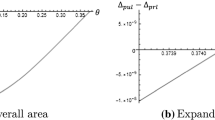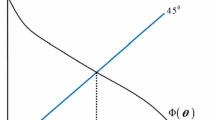Abstract
We investigate the relationship between competition and privatization policies. Existing studies measure the strength of competition based on the number of firms, and show that the optimal degree of privatization is higher in more competitive markets. We introduce an interdependent payoff structure into a mixed oligopoly and revisit this problem. Here, we assume that firms consider their own and other firms’ profits. In the model, competition increases when firms are negatively affected by rivals’ profits. We find that under the assumption of quadratic production costs, which is popular in mixed oligopolies, the optimal degree of privatization is higher when there is less market competition. This finding contrasts with those of prior studies. However, this result may be reversed when we adopt alternative model formulation. Furthermore, in the constant marginal cost case, the optimal degree of privatization is always lower when there is less market competition, which is opposite to the result in the quadratic cost case. Our results suggest that the relationship between an optimal privatization policy and the strength of competition crucially depends on the market structure, including the cost conditions.
Similar content being viewed by others
Notes
This interest in mixed oligopolies is the result of their importance to European, Canadian, and Japanese economies. Although they are less significant, there are some examples of mixed oligopolies in the United States, such as the packaging and overnight-delivery industries. Analyses of mixed oligopolies date back to at least (Merrill and Schneider 1966), although it is only more recently that the literature in this field has become richer and more diverse. See Gil-Moltó et al. (2011) and Bose and Gupta (2013), and the works referenced therein, for recent developments in this field.
Partial ownership in privatized firms has become increasingly popular worldwide and, as a result, partial privatization has been discussed intensively in the literature. For a general discussion, see Matsumura (1998). In addition, see Ishibashi and Kaneko (2008) for quality-improving investments, Kato (2006, 2013) for environmental problems, Matsumura and Kanda (2005), Fujiwara (2007), Wang and Chen (2010) and Cato and Matsumura (2012) for free-entry markets, Bárcena-Ruiz and Garzón (2003) for merger problems, and Matsumura and Ogawa (2010), Bárcena-Ruiz and Garzón (2010), and Naya (2015), who examine the endogenous timing game.
For a general discussion of this approach, see Matsumura et al. (2013).
Under the standard conditions in a Cournot oligopoly, the ratio between profit margin (price less marginal cost) and the price, known as Lerner index, is decreasing in \(\alpha \). This index is popular in the empirical literature as a measure of the intensity of market competition in product markets. Furthermore, Matsumura and Matsushima (2012) show that collusion is less stable when \(\alpha \) is larger under moderate conditions. In this sense, a larger \(\alpha \) again indicates a more competitive market.
The conjectural variation approach is another possibility, and contains three models as special cases. However, the conjectural variation model assumes that firm 1’s output affects that of firm 2, and vice versa. Needless to say, this assumption is inconsistent in any static model. One advantage of the interdependent payoff approach is that it does not suffer from this problem.
See Gibbons and Murphy (1990) for empirical evidence. The payoff function based on relative wages or relative wealth status has also been intensively discussed in the macroeconomics context.
See Armstrong and Huck (2010), and the works referenced therein.
See Vega-Redondo (1997) for an evolutionary game model in this regard. He considers a quantity-setting model in a homogeneous product market, and shows that if firms myopically imitate the most profitable firm’s strategy, the industry converges to a highly competitive outcome.
See Fumas (1992) and Kockesen et al. (2000). Although we do not endogenize this parameter, we presume that the owners of private firms set \(\alpha \) as positive if they are able to do so. However, the owner of a public firm may have little incentive to choose a positive \(\alpha \). From this viewpoint, the alternative model formulation of payoffs discussed in Sect. 4 is important.
If we replace \(V_i\) with \(\pi _i\), this becomes the standard formulation of the payoff for a semi-public firm (Matsumura 1998). See also Fujiwara (2007) for recent works adopting this approach. We assume that W represents the sum of the consumer surplus and the profits of firms, rather than the sum of the consumer surplus and the payoff of all firms, \(V_0+V_1+\cdots +V_n\). CEOs of firms might be concerned with the relative performance of their firms because good relative performance will increase their current and future incomes. However, we regard this simply as an income transfer.
For example, De Fraja and Delbono (1989) discuss the case of \(\alpha =0\), and show that there exists m such that a private oligopoly (\(\theta =1\)) yields greater welfare than a mixed oligopoly (\(\theta =0\)) if and only if \(n>m\).
In this setting, the payoff of each private firm is non-negative in the symmetric equilibrium, whereas it could have been negative in the original setting. This might be another advantage of this alternative formulation over the original formulation. However, in the alternative formulation, \(\theta =1\) does not imply a symmetric private oligopoly. In contrast, in the original formulation, we can treat a symmetric private oligopoly as a special case. This is an advantage of the original formulation discussed in Sect. 3.
If \(c_0 = 0\), the first-best outcome is achieved and the optimal degree of privatization is zero. See Bárcena-Ruiz (2012).
References
Armstrong M, Huck S (2010) Behavioral economics as applied to firms: a primer. CESIFO working paper 2937
Bárcena-Ruiz JC (2012) Privatization when the public firm is as efficient as private firms. Econ Model 29(4):1019–1023
Bárcena-Ruiz JC, Garzón MB (2003) Mixed duopoly, merger and multiproduct firms. J Econ 80(1):27–42
Bárcena-Ruiz JC, Garzón MB (2010) Endogenous timing in a mixed oligopoly with semipublic firms. Portuguese Econ J 9(2):97–113
Bose A, Gupta B (2013) Mixed markets in bilateral monopoly. J Econ 110(2):141–164
Cato S, Matsumura T (2012) Long-run effects of foreign penetration on privatization policies. J Inst Theor Econ 168(3):444–454
Cato S, Matsumura T (2013) Long-run effects of tax policies in a mixed market. Finanz Archiv 69(2):215–240
Cato S, Matsumura T (2015) Optimal privatization and trade policies with endogenous market structure. Econ Rec. doi:10.1111/1475-4932.12189
De Fraja G, Delbono F (1989) Alternative strategies of a public enterprise in oligopoly. Oxford Econ Pap 41(2):302–311
Fjell K, Pal D (1996) A mixed oligopoly in the presence of foreign private firms. Can J Econ 29(3):737–743
Fujiwara K (2007) Partial privatization in a differentiated mixed oligopoly. J Econ 92(1):51–65
Fumas VS (1992) Relative performance evaluation of management : the effects on industrial competition and risk sharing. Int J Ind Organ 10(3):473–489
Gibbons R, Murphy KJ (1990) Relative performance evaluation for chief executive officers. Ind Labor Relat Rev 43(3):30–51
Gil-Moltó MJ, Poyago-Theotoky J, Zikos V (2011) R&D subsidies, spillovers and privatization in mixed markets. South Econ J 78(1):233–255
Han L, Ogawa H (2008) Economic integration and strategic privatization in an international mixed oligopoly. Finanz Archiv 64(3):352–363
Haraguchi J, Matsumura T (2014) Price versus quantity in a mixed duopoly with foreign penetration. Res Econ 68(4):338–353
Ishibashi I, Matsumura T (2006) R&D competition between public and private sectors. Eur Econ Rev 50(6):1347–1366
Ishibashi K, Kaneko T (2008) Partial privatization in mixed duopoly with price and quality competition. J Econ 95(3):213–232
Ishida J, Matsumura T, Matsushima N (2011) Market competition, R&D and firm profits in asymmetric oligopoly. J Ind Econ 59(3):484–505
Kato K (2006) Can allowing to trade permits enhance welfare in mixed oligopoly? J Econ 88(3):263–283
Kato K (2013) Optimal degree of privatization and the environmental problem. J Econ 110(2):165–180
Kockesen L, Ok EA, Sethi R (2000) The strategic advantage of negatively interdependent preferences. J Econ Theory 92(2):274–299
Lin MH, Matsumura T (2012) Presence of foreign investors in privatized firms and privatization policy. J Econ 107(1):71–80
Matsumura T (1998) Partial privatization in mixed duopoly. J Publ Econ 70(3):473–483
Matsumura T (2003) Endogenous role in mixed markets: a two-production period model. South Econ J 70(2):403–413
Matsumura T, Kanda O (2005) Mixed oligopoly at free entry markets. J Econ 84(1):27–48
Matsumura T, Matsushima N (2004) Endogenous cost differentials between public and private enterprises: a mixed duopoly approach. Economica 71:671–88
Matsumura T, Matsushima N (2012) Competitiveness and stability of collusive behavior. Bull Econ Res 64(s1):s22–s31
Matsumura T, Matsushima N, Cato S (2013) Competitiveness and R&D competition revisited. Econ Model 31(1):541–547
Matsumura T, Ogawa A (2010) On the robustness of private leadership in mixed duopoly. Aust Econ Pap 49(2):149–160
Matsumura T, Shimizu D (2010) Privatization waves. Manchester School 78(6):609–625
Matsumura T, Sunada T (2013) Advertising competition in a mixed oligopoly. Econ Lett 119(2):183–185
Matsumura T, Tomaru Y (2012) Market structure and privatization policy under international competition. Jap Econ Rev 63(2):244–258
Matsumura T, Tomaru Y (2013) Mixed duopoly, privatization, and subsidization with excess burden of taxation. Can J Econ 46(2):526–554
Mujumdar S, Pal D (1998) Effects of indirect taxation in a mixed oligopoly. Econ Lett 58(2):199–204
Mukherjee A, Zhao L (2009) Profit raising entry. J Ind Econ 57(4):870
Merrill W, Schneider N (1966) Government firms in oligopoly industries: a short-run analysis. Q J Econ 80(3):400–412
Naya JM (2015) Endogenous timing in a mixed duopoly model. J Econ. doi:10.1007/s00712-014-0416-2
Nishimori A, Ogawa H (2002) Public monopoly, mixed oligopoly and productive efficiency. Aust Econ Pap 41(2):185–190
Pal D (1998) Endogenous timing in a mixed oligopoly. Econ Lett 61(2):181–185
Tomaru Y, Kiyono K (2010) Endogenous timing in mixed duopoly with increasing marginal costs. J Inst Theor Econ 166(4):591–613
Vega-Redondo F (1997) The evolution of Walrasian behavior. Econometrica 65(2):375–384
Wang LFS, Chen TL (2010) Do cost efficiency gap and foreign competitors matter concerning optimal privatization policy at the free entry market? J Econ 100(1):33–49
Wang LFS, Lee JY (2013) Foreign penetration and undesirable competition. Econ Model 30(1):729–732
Author information
Authors and Affiliations
Corresponding author
Additional information
We are indebted to two anonymous referees and the editor for their valuable and constructive suggestions. We also thank seminar participants at annual meeting of Japanese Economic Association, National Dong Hwa University, Osaka University, and The University of Tokyo for their helpful comments. Needless to say, we are responsible for any remaining errors. This work was supported by Murata Science Foundation and JSPS KAKENHI Grant Numbers 15k03347.
Rights and permissions
About this article
Cite this article
Matsumura, T., Okamura, M. Competition and privatization policies revisited: the payoff interdependence approach. J Econ 116, 137–150 (2015). https://doi.org/10.1007/s00712-015-0445-5
Received:
Accepted:
Published:
Issue Date:
DOI: https://doi.org/10.1007/s00712-015-0445-5




